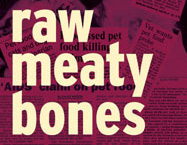
 | FOR PET OWNERS |
 | ARTICLES |
 | RMB NEWSLETTER ARCHIVE |
 | MEDIA ARCHIVE |
 | MISCELLANEOUS |
 | ABOUT THIS WEBSITE |

Visit our photo gallery
Bligh Park Pet Health Centre
Dr Mei Yam & Associates
Feed Your Dog Raw Meaty BonesAs with any new venture the better informed we are the easier the task. Also, when well informed, fears tend to fade into insignificance. FEAR, by the way, is an acronym for False Expectations Appearing Real. Fortunately, dogs seldom share our fears and wolf down the first raw meaty bone they are offered. The Diet Guide provides lists of suitable raw meaty bones and offal. Table scraps can be almost anything from your own plate with notable exceptions such as cooked bones, onion, garlic and raisins. Circumstances vary and dogs come in different ages and sizes. However, some generalisations apply. Quality The closer you follow the natural ideal the better. Feed whole carcasses whenever you can and otherwise base your feeding regime on raw meaty bones in large pieces from a variety of animals. However, wolves frequently depend on meat from a single prey species, for instance deer, and there are lots of pet dogs that eat chicken at every meal. Quantity Aim for 70% or more of the diet as raw meaty bones. Thereafter, the remaining percentage can be made up of offal, table scraps, and large lumps of meat or more raw meaty bones. Nature, thankfully, is tolerant and allows a range of options that provide for good health. Daily food intake varies. As a percentage of body weight, giant breeds tend to need less and small breeds need more food. Working dogs, breeding and lactating females and growing puppies need more food than do less active dogs. As a guide, healthy adult dogs usually require between 2% and 3% of their body weight in food daily. Over the course of a week, in round figures, that amounts to 15% to 20% of body weight. For example, if your dog weighs 10 kilos he will likely need between 1.5 and 2 kilos of raw meaty bones each week. If you measure in pounds weight then the sums are the same. Perhaps your dog weighs 20 pounds. Then you can expect to feed her between 3 and 4 pounds of food each week. A good rule of thumb, when feeding growing puppies, is to allow them daily food rations equivalent to 2%–3% of their expected body weight when fully grown. Frequency Wild dogs have no regular meal times and are used to gorging when food is available. Sometimes they go days between meals. In a domestic setting once-a-day feeding works best for most pets and their owners. It’s a good idea to feed your dog when you are at home to watch over and see your dog enjoy his meal — which for many people is in the evening. Always strive to feed the raw meaty bones in one large lump. This maximises the time spent gnawing and chewing which is good for dental cleaning. It also minimises the chances of a small piece being swallowed whole and getting stuck. Healthy dogs benefit from one or two days fasting each week. Research shows that slim dogs (and people) tend to be healthier and live longer. Sick and elderly dogs and growing puppies should not be fasted. Getting started When getting started, keep it simple. Over time it’s a good plan to feed raw meaty bones and offal from a range of animals. But in the first couple of weeks stick with one source. Chicken is relatively cheap and readily available. Tiny dogs do well on chicken wings and thighs. Larger dogs may need a whole chicken. And for economy, chicken frames, with most of the meat removed for human consumption, are a good source of food. What other preparation is needed? You may need a bowl in which to feed table scraps. For the main food items — the large lumps of raw meaty bones and offal — simply hand them to your dog. That’s easy if you have a grassy lawn where she can dine in comfort. If your dog needs to eat indoors then feed her in the kitchen, laundry or even in the shower cubicle. By spreading some newspaper, a towel or mat you make cleanup easier. Take care and have fun Raw meaty bones act as nature’s toothbrush, toothpaste and dental floss combined. Many dogs affected by bad breath and sore gums gain a return to good oral health after a couple of weeks on a natural diet. However, dogs suffering more severe dental problems may need dental treatment before commencing a natural diet. (See 12 year old Maltese Tess receiving dental treatment followed by her remarkable recovery.) Dogs ‘like’ bones very much and sometimes become protective. Do take care and discourage young children from approaching dogs that are eating. Your professional dog trainer can advise. The first time you hand your dog a raw meaty bone can be as momentous or as mundane as you choose to make it. But it will be the start of a whole new way of life for you and your pet. So, having a camera handy could be useful, as could keeping a diary. In years to come you will be able to share evidence of your pioneering efforts with your grandchildren as you look back with pride.  Feed your dog Raw Meaty Bones (PDF version) Feed your dog Raw Meaty Bones (PDF version)
|
| Raw Meaty Bones |